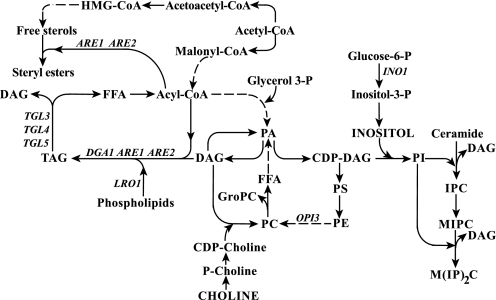FIGURE 1.
Major pathways for the synthesis of phospholipids, inositol complex sphingolipids, and neutral lipids. The synthesis of phospholipids and neutral lipids shares DAG and PA as common precursors. In the synthesis of phospholipids, PA serves as the immediate precursor of CDP-DAG, which is in turn the precursor of both PI and PS. PS is converted sequentially into phosphatidylethanolamine (PE) and PC. PA also serves as a precursor for phosphatidylglycerol phosphate and ultimately cardiolipin (not shown). PA alternatively serves as a precursor of DAG, and PC can also be synthesized from DAG and CDP-choline. DAG also serves as the precursor for TAG and can be phosphorylated to regenerate PA. The synthesis of free sterols and fatty acids share acetyl-CoA as a common precursor. Acyl-CoA serves as fatty acid pool for the synthesis of PA, TAG, and SE. In the synthesis of inositol-containing sphingolipids, inositol phosphate derived from PI is sequentially transferred to ceramide to form IPC and to MIPC to form M(IP)2C, releasing DAG at each of the two steps. The names of the structural genes that are discussed in detail in this report are shown adjacent to the arrows of the metabolic conversions in which they are involved. FFA, free fatty acids. HMG, 3-hydroxy-3-methyl-glutacyl.

